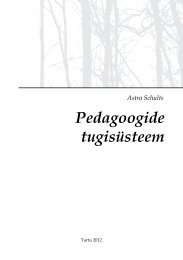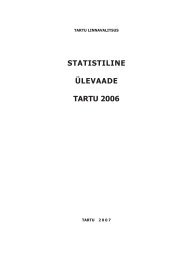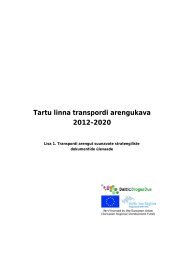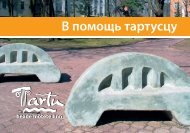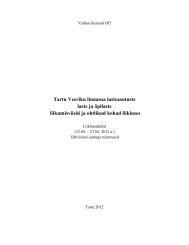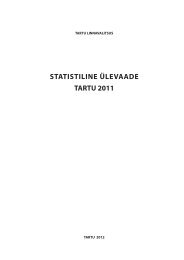Festivals - Tartu
Festivals - Tartu
Festivals - Tartu
You also want an ePaper? Increase the reach of your titles
YUMPU automatically turns print PDFs into web optimized ePapers that Google loves.
To insist on a strictly local character of festival in terms of political and social support,<br />
economic impact, targeted audience and artistic talent promises little prospect of<br />
development and growth and entails the risks of stagnation and parochialism. Even a<br />
smaller community will embark on a festival adventure in the hope of attracting visitors<br />
form the outside, some tourists perhaps, and strive to combine cultural uniqueness<br />
with economic opportunities such as additional jobs or outside investments. In<br />
very small places, the major motives for a festival are often predominantly driven by<br />
tourism interests, that is economical rather than artistic objectives. There is nothing<br />
inherently wrong in this duality of purposes as long as those objectives could be held<br />
clearly apart as different developmental dimensions, if all involved reach a consensus<br />
what must be the priority, if they are as stakeholders capable of managing the emerging<br />
tension in contradictory expectations, without enmeshment and crossing agendas,<br />
thus avoiding conflict, blaming and disappointments.<br />
If in a very small place festival brings a boost to normal cultural life, in a larger city,<br />
where much happens through the normal cultural season anyhow, a festival makes<br />
sense only if it brings something unusual and extraordinary that the regular programming<br />
of the venues is not capable of providing. In this situation, an international festival<br />
is not a sheer continuation of the theater season but a peak in a strong regular<br />
programming that seek to surprise and provoke.<br />
The context, as shaped by the place and its cultural infrastructure and program richness,<br />
determines the sense and the function of each festival as it strives to enhance the<br />
local advantages with international elements. Take Venice, a city of remarkably rich<br />
theater history where in the 17 and 18th century several theaters offered every evening<br />
a varied repertory to several thousand viewers. Today, Venice abounds in museums,<br />
churches and architectural splendors but Venetians are forced to go even for a cinema<br />
across the lagoon, to Mestre, and their city offers throughout the year hardly any<br />
quality concerts and theater performance. After much procrastination and criminal<br />
mismanagement, the opera La Fenice, gutted by fire in 1996, was rebuilt and festively<br />
opened in November 2003 - only to be closed for another year of final works. Only<br />
from 2005 one could hope La Fenice will offer 3-4 performances a week. Otherwise,<br />
performing arts are scarcely represented in Venice and therefore the Biennale programming<br />
at the end of every second summer gives a chance to bring special productions<br />
that will match the extraordinary richness of the visual arts exhibit and pool<br />
art connoisseurs as well as tourists. Unfortunately, in the last few editions, Biennale<br />
could not afford more than 2-3 productions, a skeleton festival as it were, not much<br />
to make a point, too short to appeal much to the tourists and too brief to make a real<br />
difference for the inhabitants. After the Biennale, Venice slides back in the performing<br />
arts swamp.<br />
29



